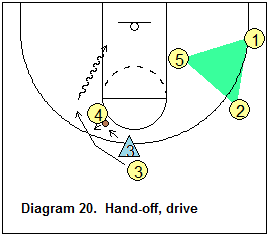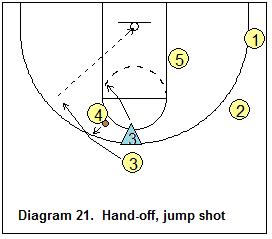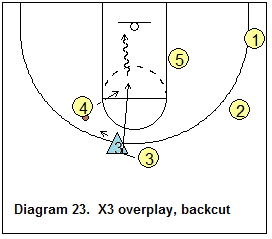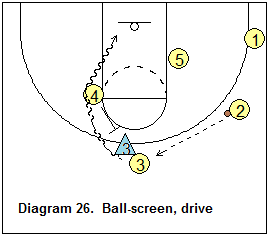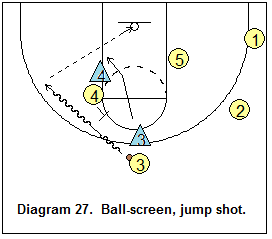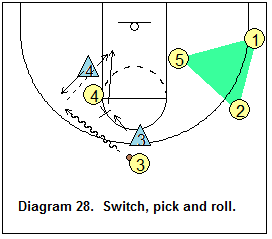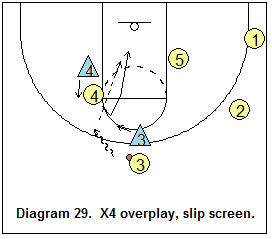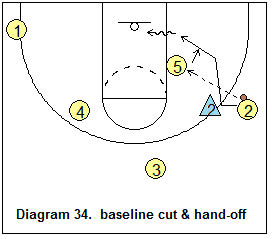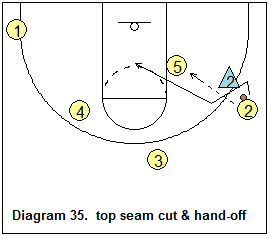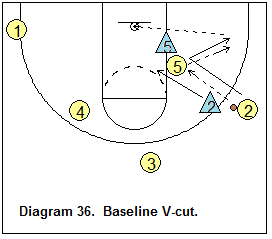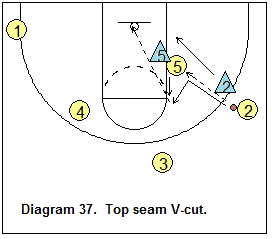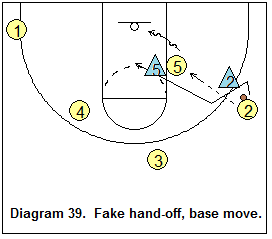Basketball Offense - The Triangle Offense (Part 2) - the 2-Man Game
From the Coach’s Clipboard Basketball Playbook"Helping coaches coach better..."
First see the lead article on the Triangle Offense, which discusses how to establish the sideline triangle with a number of possible entries, and the many options off the sideline triangle. Next, post offense options are detailed.
This article discusses the 2-man game options, including the weakside 2-man game (opposite the sideline triangle), and also the strongside 2-man options.
To review, in the diagrams below, we see the triangle offense set (could be either right or left side of court). The sideline triangle is comprised of a post player on the block and two perimeter players, one on the wing and one in the corner. The 2-man weakside offense consists of a guard at the top, and a post player at the weakside elbow-extended area (pinch post).


Now we'll discuss the 2-man game options.
Weakside Two-Man Game
The weakside "two-man game" is a really powerful weapon in the triangle offense. This is usually set up by a pass from the wing back out to the top. For example, in diagram 19, if the wing pass (O2) to the post or corner is denied, the pass should go back out on top to O3. The diagram also shows a double-screen option for O1.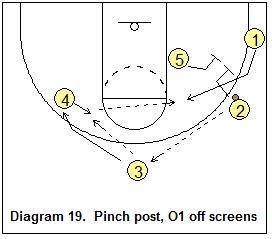
The weakside options can be categorized as (1) options off the pass to the weakside post (O4), and (2) options off a ball-screen and dribble from the top (O3). The later occurs when the pass to the post O4 is being denied, so O4 ball-screens for O3 on the top. With all of these options, it's a matter of reading and reacting to the defense.
Options off the pass to the pinch post (O4)
O3 passes to O4 at the weakside elbow area, and then follows the pass and cuts around O4 for a possible hand-off.Options off the pass to weakside post
- Hand-off and drive - diagram 20. With the X3 defender trailing, O3 gets the hand-off and dribble-drives to the hoop.
- Hand-off and jump-shot... diagram 21. X3 defender goes under the screen, so O3 gets the hand-off and pulls-up for a jump shot.
- Hand-off and pick and roll - diagram 22. Defense switches on the hand-off, so O3 and O4 run a pick and roll, with a pass inside to O4. Or O4 can clear-out to either the corner or the top, and let O3 take the slower X4 defender 1-on-1.
- O3 cuts inside on X3 overplay - diagram 23. If the X3 defender overplays and denies O3's hand-off cut, O3 back-cuts right down the lane for the pass and lay-up.
- Fake hand-off and drive (O4) - diagram 24. O4 fakes the hand-off to O3 and dribble-drives to the hoop. This is especially effective if O4 senses the X4 defender is cheating over (jump-switching) on the the hand-off.
- Lob to O4 on pass denial - diagram 25. X4 denies the pass to O4. Since there is often no helpside defender, O3 can lob pass to O4 back-cutting to the hoop.
If the pass to the post O4 is denied, O4 ball-screens for O3.
Options off the ball-screen and dribble from the top
- Ball-screen and dribble-drive - diagram 26. O3 dribbles around the screen to the hoop.
- Ball-screen and jump-shot - diagram 27. The X3 defender goes under the screen, so O3 comes off the screen with a pull-up jump shot.
- Ball-screen and pick and roll - diagram 28. Defense switches the screen, so O3 and O4 run a pick and roll, with a pass inside to O4. Or O4 clears-out to either the corner or the top, to let O3 take the slower X4 defender 1-on-1.
- Post O4 slips the screen on X4 overplay - diagram 29. O4 goes to set the ball-screen for O3. O4 senses the X4 defender is cheating over the screen (jump-switching), and "slips" the screen with a back-cut, for the pass from O3.
- O3 crossover dribble on X3 overplay - diagram 30. If the X3 defender overplays O3, denying the path around the screen, O3 crossover dribbles right down the lane for the lay-up.
- Lob to O4 on pass denial - diagram 25 (above). X4 denies the pass to O4. Since there is often no helpside defender, O3 can lob pass to O4 back-cutting to the hoop.
Strong-side two-man game
We can also run a two-man game on the strong-side (triangle side). There are several ways to set up the ball-side two-man game. Diagram 31 reviews how O1 passes to the wing O2 and cuts through for a possible give and go play. If O1 doesn't get the ball, he/she can cut out to the opposite corner, leaving a two-man option with the wing O2 and O5 in the low post.
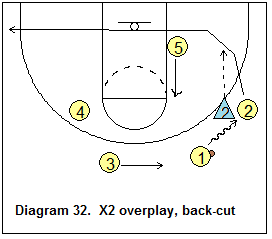
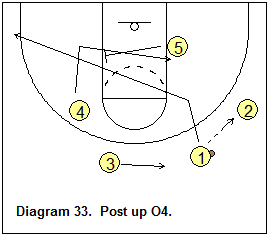
Diagram 32 reviews the dribble to the wing, with X2 denying the wing pass. Our wing player O2 back-cuts for a possible pass and layup. If O2 does not get the pass, he/she cuts to the opposite corner, again leaving a two-man setup for O1 and O5.
Diagram 33 shows how we can get O4 in the post by having O5 screen for O4. This is a good option if O5 can't get open for the pass - instead he/she screens away for O4. O1 passes to the wing O2 and cuts to the opposite corner. Now we have the two-man set with O2 and O4.
Ball-side two-man options
Here are several options the two players can run, again reading and reacting to the defense.Wing player options after pass into the post
- Baseline cut and hand-off - diagram 34. With the X2 defender playing high (forcing baseline), O2 cuts around the baseline side of O5 for a possible hand-off and layup.
- Top seam cut and hand-off - diagram 35. X2 defender is overplaying the baseline cut. O2 cuts into the top seam around O5 for a possible jump shot or layup.
- Baseline V-cut and jump shot - diagram 36. The X2 defender slides over the screen (or switches with X5). O2 v-cuts to the short corner for the pass and a jump-shot. If the defense switches the screen, O2 might be able to make the quick pass back into O5 who has a mis-match with the smaller X2 defender.
- Top seam V-cut and jump shot - diagram 37. If the X2 defender goes under the screen, O2 v-cuts to the elbow-free throw line area for the pass and jump shot.
Post player options
- Fake hand-off and move to the lane - diagram 38. If O2 cuts baseline, and the X5 defender is hedging that way, O5 can fake the hand-off and make a quick move to the lane.
- Fake hand-off and baseline move - diagram 39. O2 cuts into the top seam. X5 is cheating toward the top to stop O2. O5 fakes the hand-off and makes the power baseline drop-step move.
- 1-on-1 post moves - If the hand-off or pass to the wing O2 is not there, O2 cuts through to the opposite side (and screens for the weakside post (O4). O4 cuts to the ball-side elbow for a possible jump shot. This leaves O5 with a 1-on-1 situation with the X5 defender.
- Post ball-screens for wing - If X5 is denying the pass into the post O5, O5 can set a ball-screen for the wing player O2, and run a pick and roll play.
Reading and reacting to the defense
We have already discussed a number points that have to do with reading and reacting to the defense - reading the post defense, reading wing pass denial, the wing reading and reacting to his defender sagging in the post, and reading the weakside and strong-side "two-man" options. Here we'll discuss a few more.Diagram 40. The ball is on the wing (O2), the low post is being denied, and the X3 defender is denying the pass to the top. An important "read" for the weakside post O4 is to recognize when the pass to the top is being denied. When this happens, O4 cuts to the ball-side free-throw line area to receive the pass from the wing (O2). O3 reads X3's defensive overplay and back-cuts around O4 for a possible pass and lay-up (1st option).
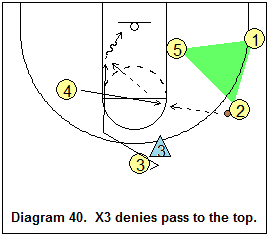
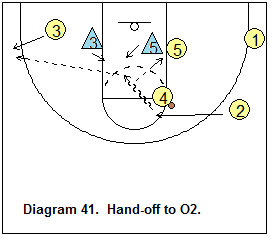
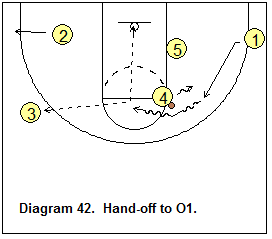
Diagram 41. If the pass to O3 is not there, O2 cuts around O4 for a hand-off (2nd option), with all the hand-off options discussed above under weakside options. O2 may have a layup, a pull-up jump shot, a dump-pass to O5, or a kick-out pass to O3.
Diagram 42. If O4 does not hand-off to O2, O1 cuts around O4 for another possible hand-off option (3rd option). Or O4 may keep the ball and take an elbow jump shot (4th option). O1 could have a jump shot or a kick-out to O3. If the pass goes to O3 on the opposite wing, it's easy to establish a new sideline triangle on the left side, with O5 cutting over to the left low block. O4 would be the weakside post, and O1 would pop out on top.



We'll re-visit three diagrams from above's discussion. Diagram 4B shows the X4 defending, bumping and denying the weakside post O4's cut to the ball-side elbow. O4 reads this and back-cuts for a possible lob pass from O2.
Diagram 18 shows O5 caught in a double-team, with the double coming from the opposite wing defender X3. The skip pass to the opposite wing O3 is the counter. O1 cuts baseline, receives a screen from O4 and goes to the opposite corner. If the X1 and X4 defenders switch that baseline screen, O4 can post up the smaller X1 on the block. Additionally, the extra pass from O3 to O1 in the corner often results in a wide-open corner shot.
Diagram 4 again shows the wing player O2 with the ball reading the X2 defender sagging inside to deny the post. O2 attacks the top seam with the dribble, or could shoot the 3-point shot.
In summary, the Triangle Offense features good spacing, cutting, passing, post play, and a basic set with five spots that must be filled. From there, it's basically learning to read and react to the defense and take what the defense gives you.
The article in the members section and Playbook includes a detailed Animation!
Related page:
